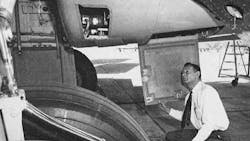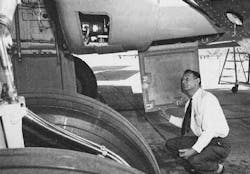50 Years Ago — Boeing 727 Hydraulics: More and Better
The 727 makes greater use of hydraulic power over its predecessors, the 707 and the 720. That’s the story from author James E. Klansnik, Hydraulic Group System Engineer at The Boeing Co., Seattle, in our July 1964 issue. Reliability and maintainability studies determined the areas on which system and component-design development should be focused — all flight controls and the aft passenger-entry stairs, integral parts of the airplane. To provide this, the 727 has dual hydraulic systems, as well as a smaller, isolated standby system offering alternate power for the leading-edge slat and flap system. This standby system is also a third power source for the rudder because it doesn’t have a manual backup system. All three systems use Skydrol 500A hydraulic fluid and operate at 3,000 psi.
Improvements to the 727 include:
- Plumbing — Tube fittings, hose materials, and static and dynamic seals were updated. Unions, tube bends, and angled fittings replaced universal-type fittings (locknuts, O-rings, and banjo fittings) to reduce leaks. The 727 has approximately 20% fewer tube assemblies than normally used.
- New seals developed — Static and dynamic seals made from elastomers have long been a problem because they don’t have the resiliency, abrasion resistance, and volumetric stability required. Recently developed ethylene propylene rubber has the necessary qualities and seals made from this are being phase in.
- Teflon hose — All hose assemblies are Teflon-lined, exposed wire-braid type with swaged-on couplings. Swaged-on couplings were chosen because they offer the tightest joint and are foolproof for assembly and installation.
- Pump choice — Two engine-driven pumps are available. A new specification was developed for a 6-gpm motor pump. It comes in two versions — one is a redesign of an existing pump adapted to work with Skydrol 500A. The other is an outgrowth of two design objectives in the motor-pump requirements: one, that the motor pump has no external dynamic seals, and two, the gearbox needs to be eliminated.
- Filter design — Filtration in and out of pumps was improved with metallic-element filters. They feature 10-μm nominal, 25-μm absolute ratings. Filters in the pump-case drain and pressure lines are nonbypass types.
Read the complete article by clicking here.


